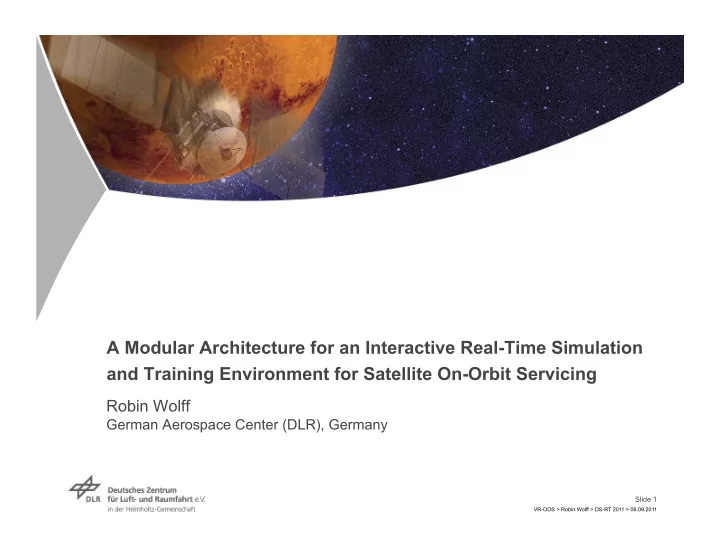

A Modular Architecture for an Interactive Real-Time Simulation and Training Environment for Satellite On-Orbit Servicing Robin Wolff German Aerospace Center (DLR), Germany Slide 1 VR-OOS > Robin Wolff > DS-RT 2011 > 06.09.2011
Outline Motivation � Physical Mock-up � Project Goal � System Overview � Servicing Tasks � System Components � Distributed Simulation Architecture � Framework Structure � Communication Layer � Implemented Modules � Summary � (Servicing the Hubble Space Telescope - NASA) Slide 2 VR-OOS > Robin Wolff > DS-RT 2011 > 06.09.2011
Motivation On-Orbit Servicing � Analyse & Repair Failures � Lifetime Extension � (Space Debris - NASA) (Ellery et al. 2008) Remove Space Debris � Manned Missions � Expensive and Risky � Exhausting for Astronauts � (DEOS – DLR/STI) Increased Use of Space Robots � (Astronaut during EVA - DLR/ESA) Autonomous Operation � Controlled via Tele-Operation � (Control for Canadarm2 - MDA) (SPDM on Canadarm2 - MDA) Slide 3 VR-OOS > Robin Wolff > DS-RT 2011 > 06.09.2011
Humanoid Service Robot Light Weight Robot (LWR) � 7 Axes � Weight: 14kg, Payload: 14kg � Space Justin � 49 Joints � Sensors � Stereo Camera � Laser Stripe Sensor � 41 Position Sensors � 43 Torque Sensors � Workspace: approx. 1.7m � Weight: 45kg, Payload: 15kg � Slide 4 VR-OOS > Robin Wolff > DS-RT 2011 > 06.09.2011
Bimanual Haptic Interface Based on LWR � Bimanual Control � Magnetic Safety Linkage � Tracking via Rotation Sensors in Joints � Haptic Feedback via Robot’s Motors � Slide 5 VR-OOS > Robin Wolff > DS-RT 2011 > 06.09.2011
Physical Mock-up Tele-Presence Interface demonstrated at ILA 2010 in Berlin � Slide 6 VR-OOS > Robin Wolff > DS-RT 2011 > 06.09.2011
Project Goal Create an Immersive Virtual Environment � for the Simulation of On-Orbit Servicing Tasks Applications: � Analysis, Training, Programming � & Tele-Operation of On-Orbit Servicing Tasks Service Robot in Space Design of new serviceable � Satellite Systems Design of new Service Robots � and Tools Operator at Ground Control Project Partners: � DLR Robotics and Mechatronics � DLR Simulation and Software Technology � VR Environment Project Time 3 years (started Jan 2010) � Slide 7 VR-OOS > Robin Wolff > DS-RT 2011 > 06.09.2011
Servicing Tasks Remove Multi-Layer Insulation (MLI) � Loosen / Tighten Screws � Plug / Unplug Cable Connectors � Remove / Insert Modules � (using a Bayonet Handle) Operate Switches � Take Measurements � (e.g. using a Voltmeter) Virtual Satellite Mock-up Physical Satellite Mock-up EVA Task Sheet Slide 8 VR-OOS > Robin Wolff > DS-RT 2011 > 06.09.2011
System Components Slide 9 VR-OOS > Robin Wolff > DS-RT 2011 > 06.09.2011
Requirements Shared Functionality? Real-Time Requirements � � Duplicate Code? Highly Realistic Simulation � � Shared Scene Description? Complexity vs. Accuracy � � Dedicated Machines � Logic Tele-Robot Haptic Device F F Manager x x >1kHz F F x x GPU Visualization Physics Simulation 30-60Hz ~60Hz Slide 10 VR-OOS > Robin Wolff > DS-RT 2011 > 06.09.2011
Distributed Simulation Architecture Common Processing Loop Wraps Common Functionality � Recv. Send. Update Step Distribute Unified Scene Management � Simulation Simulation Changes Transparent Processing Loop � Read & Modify Interpret Collect Asynchronous Message Passing � Updates Changes Modular Architecture Common � Spec. Generic Structure � Simulation State Common Interface � Easily Extensible � Manager Physics Haptics Visualization Simulation Simulation Simulation Simulation Scene Scene Scene Scene … Communication Communication Communication Communication Server Client Client Client Slide 11 VR-OOS > Robin Wolff > DS-RT 2011 > 06.09.2011
Communication Layer Configurable Queuing Schemes � A C B A C D A B FIFO (Default for State Changes, Commands) � D C B A Most-Recent (Default for Updates) � Refresh & Distribution Lists � Scene Queue only relevant Nodes D C B A � changed distribute Threshold Filter � ∆ x Send only “significant” Changes � Update Rate Monitor � t 0 t 0 +T t 1 +T Caps Update Frequency if too high � Online Performance Monitoring D C B A � distribute Keeps an Eye on System Status � Future: Automatic Reconfiguration � Slide 12 VR-OOS > Robin Wolff > DS-RT 2011 > 06.09.2011
Implemented Modules Haptic Device � Interface to HMI, Phantom Omni, Falcon � Collision Detection � Based on Voxmap-PointShell, � and OpenHaptics Visualization � Based on ViSTA VR-Toolkit, � and InstantReality Physics � Based on Bullet � Manager kinematic � body C x B F H x C F sw Based on Behavior Classes hinge α max α min � joint J static body A x A (in Future: Python) Slide 13 VR-OOS > Robin Wolff > DS-RT 2011 > 06.09.2011
Summary Modular Architecture for a Distributed � Interactive Real-Time Simulation Environment Provides Underlying Infrastructure � for Research Modules First Prototype demonstrated � Desktop, 3D-TV + Haptics � VR Display (Powerwall) � Further Work � Enhance Photo-realistic Rendering � Test other Physics Engines � GPU Implementation of VPS Algorithm � Increase Complexity of Scenes � Enable Distributed Collaboration � Slide 14 VR-OOS > Robin Wolff > DS-RT 2011 > 06.09.2011
Contact Robin Wolff robin.wolff@dlr.de Simulation and Software Technology, Software for Space Systems and Interactive Visualization (SC-RV) German Aerospace Center (DLR), Lilienthalplatz 7, 38108 Braunschweig, Germany http://www.dlr.de/sc/en Slide 15 VR-OOS > Robin Wolff > DS-RT 2011 > 06.09.2011
Recommend
More recommend